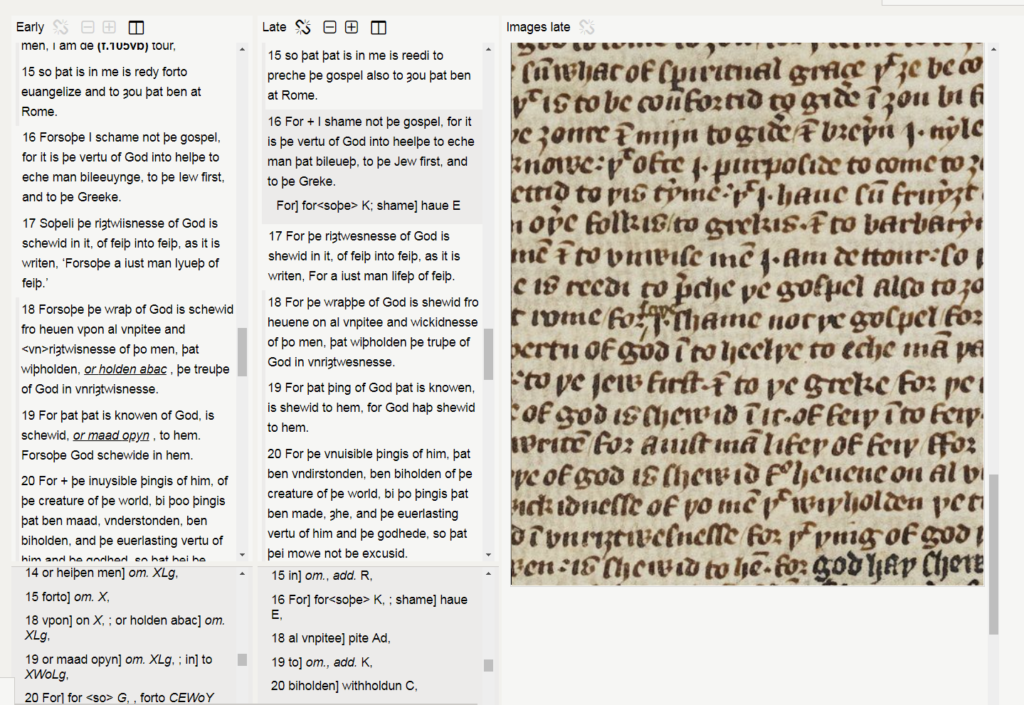The ‘Towards a New Edition of the Wycliffite Bible’ project which employs me recently put up a public prototype version of the project’s digital result: an open-access online edition of both versions of the Wycliffite Bible, designed to be expanded collaboratively in years to come. I gave a very quick paper introducing the project at Oxford’s interdisciplinary Medieval Studies meeting this week, and this seemed like a good moment to put up a new post contextualizing the project here.
First of all, what is the Wycliffite Bible? Parts of the Bible were translated into Old English before the Norman Conquest, and the Englishing of the Bible continued in glossing, quotation and selective translation in the following centuries. But the first complete English translation of the Bible occurred in the late fourteenth century. This project was probably carried out by followers of the controversial theologian John Wyclif, hence its conventional modern title.
The resulting Middle English translation survives in two redactions, normally called the Earlier Version (EV) and the Later Version (LV). Together, these two versions have around 250 full or partial manuscript witnesses, making the Wycliffite Bible, by manuscript survival, the most successful English text before print, and the most well-witnessed Bible translation in any Western European medieval vernacular.
The two versions of the Wycliffite Bible themselves are of course translations from the Latin Vulgate Bible: the translators lacked both knowledge of Greek and Hebrew and access to Hebrew and Greek biblical source texts. They knew, however, that they were producing a secondary translation, and they used Nicholas of Lyra to identify (in marginal notes) some points at which the Hebrew and Latin texts of the Old Testament differ. Their translation practices followed the Latin closely and produced English texts which were not theologically and politically contentious.
The translators’ work was also extremely scholarly. They appear to have tried to establish the best Latin source text possible, engaging in some form of textual-critical research themselves and comparing different versions of the Vulgate. They drew on various academic aids to biblical study, and when they added extra, clarificatory English words which had no equivalents in the Latin they were careful to distinguish these visually from what they regarded as the biblical text proper.
The Wycliffite Bible is, then, one of the major intellectual and literary products of later medieval England, and a body of work with much to teach us about topics such as translation practices, biblical influence, book production and textual dissemination in the period. It is also a valuable analogue for the study of other medieval Bible translations.
* * *
Unfortunately the result of the Wycliffite Bible’s success—the sheer number of surviving copies—has been an obstacle to its modern study. The first scholarly edition, by Josiah Forshall and Frederic Madden, was published in 1850. It was something of a heroic achievement in itself, with its own thirty-year production history. (As it’s now out of copyright, you can download PDFs of it from the Lollard Society website!)
However, Forshall and Madden themselves recognized some of the problems in their work—sadly, they discovered at least one important EV manuscript too late to use it, for instance—and subsequent study by scholars such as Conrad Lindberg and Mary Dove has demonstrated the acute need for a more modern edition.
So we have had AHRC funding to edit a selection of biblical books in both versions, from a core set of manuscripts which are accessible and likely to be textually significant according to our current knowledge. We will be producing a printed edition of these books, with a lengthy introduction reporting what we have discovered of the text’s history—so in some ways ‘Towards’ is the most important word in our project title.
But we will also be using these sections of edited text as the basis for a separate digital edition which is consciously designed expanded in future. This is the digital edition which we have a prototype of here. Together with our colleagues in Oxford’s IT Services, we’ve designed a system which can take fairly simple Word files containing the edition’s copy text and critical apparatus, and automatically mark those up as Text Encoding Initiative XML to be presented online.
The digital edition is in no way simply a digitization of the print edition: it has a completely different interface, which users can configure in a number of ways themselves. Here, for example, is a picture of me checking Romans 1.16 in the LV:
You can see that both EV (left column) and LV (middle column) have their critical apparatus scrolling in parallel at the bottom of the screen. By clicking on 1.16 I have expanded the verse’s specific part of the apparatus below the verse, revealing that the verse’s first word, ‘For’, had ‘-soþe’ added to it in the manuscript with the siglum K (in fact, the copy text manuscript, Bodleian Library, MS Fairfax 2), but not in any other witness yet collated. In the right-hand column you can see that I have pulled up the relevant image from K (f. 345r; these, too, can scroll in parallel with the main text) so that I can see that this does indeed happen on the manuscript page.
The edition will be open access, and this software too will be open access, stored in the Oxford Research Archive. We hope it might in the fullness of time be of use to other projects. Also, however, we hope that our use of it will enable a much longer-term collaborative effort to produce a full critical edition of the Wycliffite Bible.

Comments